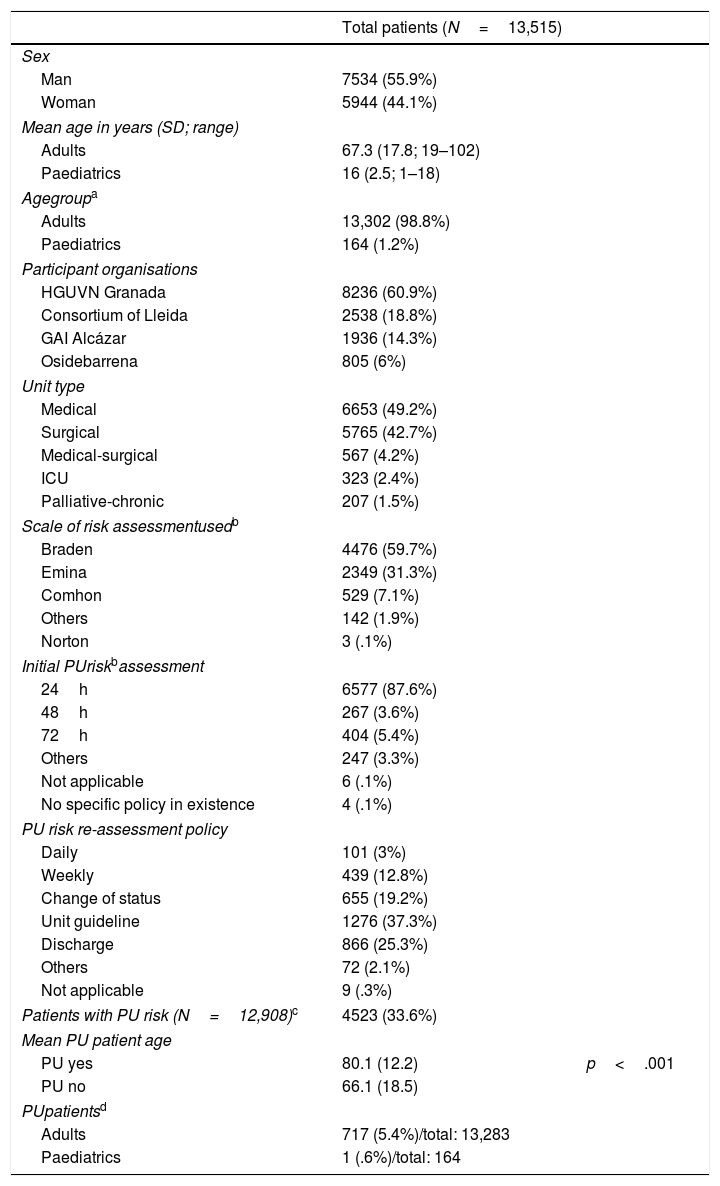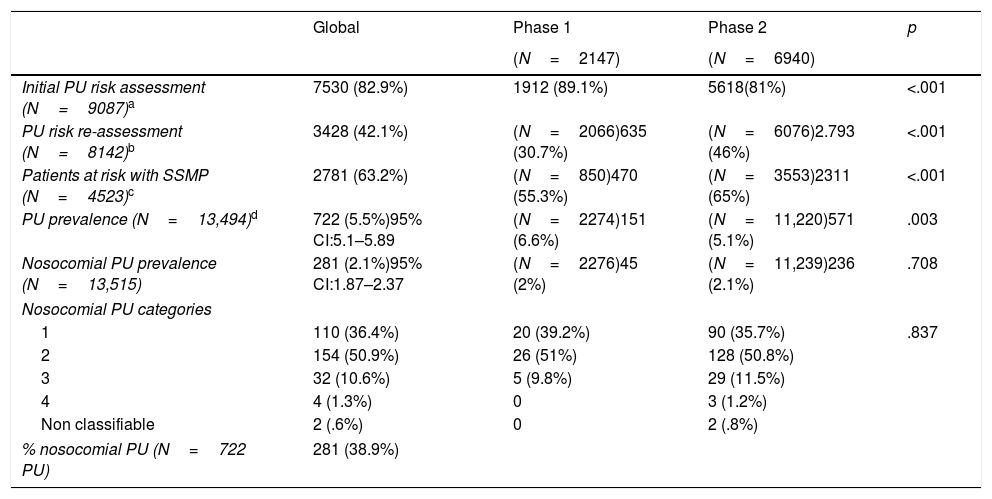To assess the impact of implementing the “Risk Assessment and Prevention of Pressure Injuries (PI)” guideline on adherence to its recommendations, the prevalence of PI and the sustainability of results, and to analyse the implementation strategies, sustainability and barriers detected.
MethodsA retrospective observational study (June 2015 to December 2018). Two periods were studied (P1: Preparation and P2: Sustainability). The programme reports and data from the medical records of patients discharged from the 4 participating hospitals were analysed with regard to adherence to preventive recommendations and health outcomes in terms of the presence of pressure injuries per centre.
ResultsA total of 13,515 patients were included, of whom 4523 were at risk for PI and 722 had PI. Of the patients, 82.9% underwent a risk assessment for PI on admission. A decrease in this assessment on admission was observed between P1:89.1% vs. P2: 81% p<.001. Of the patients at risk, 42.1% were reassessed during their admission and a significant increase was observed between the periods P1: 30.7% vs. P2:46%; p<.001. 63.2% had a special pressure management surface, with a significant increase between P1:55.3% vs. P2: 65%; p<.001. The overall prevalence of PI was 5.5% and a significant decrease was observed on comparing P1: 6.6% vs. P2:5.1%; p=.003. The prevalence of nosocomial PI remained constant at 2.1%, P1:2% and P2:2.1%; p=.708.
Institutional commitment, the appointment of leaders, drawing up of action plans, and training are outstanding strategies in all the centres.
ConclusionsThis study shows that there is adequate adherence to the main recommendations of the guideline. A statistically significant improvement was observed in adherence to 2 out of the 3 recommendations assessed. The implantation and sustainability strategies implemented have been contributed to maintenance and/or improving results over time.
Evaluar el impacto de la implantación de la guía «Valoración del riesgo y prevención de úlceras por presión» sobre la adherencia a las recomendaciones de la guía, la prevalencia de lesiones por presión (LPP) y sostenibilidad de los resultados, así como analizar las estrategias de implantación, la sostenibilidad y las barreras detectadas.
MétodoEstudio observacional retrospectivo (de junio del 2015 a diciembre del 2018). Se estudiaron 2 periodos (P1: preparación y P2: sostenibilidad). Se analizaron memorias del programa y los datos de la historia clínica de pacientes dados de alta en los 4 hospitales participantes sobre la adherencia de las recomendaciones preventivas y los resultados en salud en términos de presencia de LPP por cada centro.
ResultadosSe incluyó a 13.515 pacientes, de los cuales 4.523 tenían riesgo de LPP y 722 tenían LPP. El 82,9% de los pacientes recibieron una valoración del riesgo de LPP al ingreso. Se observó una disminución de esta valoración al ingreso: P1: 89,1% vs. P2: 81%; p<0,001. El 42,1% de los pacientes de riesgo fueron reevaluados durante el ingreso, observándose un aumento significativo entre los períodos: P1: 30,7% vs. P2: 46%; p<0,001. El 63,2% contaba con una superficie especial de manejo de presión, con un aumento significativo: P1: 55,3% vs. P2: 65%; p<0,001. La prevalencia global de LPP fue del 5,5%, observándose una disminución significativa al comparar P1: 6,6% vs. P2: 5,1%; p=0,003. La prevalencia de LPP nosocomiales fue del 2,1%, manteniéndose constante P1: 2% y P2: 2,1%; p=0,708.
El compromiso institucional, la designación de líderes, elaboración de planes de acción y la formación son estrategias destacables en todos los centros.
ConclusionesEl presente estudio muestra la existencia de una adecuada adherencia a las principales recomendaciones de la guía, observándose una mejoría estadísticamente significativa en la adherencia a 2 de las 3 recomendaciones evaluadas. Las estrategias de implantación y sostenibilidad puestas en marcha han contribuido en el mantenimiento o mejora de los resultados en el tiempo.












